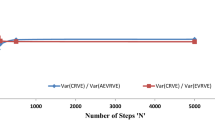Abstract
This study highlights the importance of the information contained extreme value ratios (or returns) in the volatility estimation of financial assets. Most popular extreme value estimators like Parkinson (Journal of Business, 61–65, 1980), Garman Klass (Journal of business, 67–78, 1980), Rogers Satchell (The Annals of Applied Probability, 504–512, 1991) and Yang Zhang (The Journal of Business, 73 (3), 477–492, 2000) use a subset of all available extreme value ratios but not the full set. We examine if there are other extreme value ratios which contain more information than the most widely used ratios. This study shows empirically how much information is contained in various extreme value ratios of financial assets, using both real and simulated data. Using information theory, we find out their variability in relation to a uniform distribution in each quarter. We then rank them using the Kullback–Leibler metric (in accordance with a scoring methodology we developed in this study) to ascertain which set of ratios are more variable than others and thus may provide better estimation in computing volatility. We also calculate the rank of the matrix to identify the set of linearly independent ratios, for ascertaining the number of ratios that would be enough to generate a class of volatility estimators. The empirical results demonstrate that the need for incorporating other ratios in volatility estimation. We also observe that each dataset has other more informative ratios which are uniquely attributed to that dataset.
Similar content being viewed by others
Data availability
The data that support the findings of this study are available from the corresponding author upon reasonable request.
Notes
We could not include the ranking scores of all the ratios due to brevity. However it can be made available on request.
References
Alizadeh, S., M. Brandt, and F.X. Diebold. 2002. Range-Based Estimation of Stochastic Volatility Models. Journal of Finance 57: 1047–1092.
Bollerslev, T. 1986. Generalized autoregressive conditional heteroskedas- ticity. Journal of Econometrics 31 (3): 307–327.
Beckers, S. 1983. Variances of security price returns based on high, low, and closing prices. Journal of Business 56 (1): 97–112.
Ding, Z., and C. Granger. 1996. Varieties of long memory models. Journal of Econometrics 73 (1): 61–67.
Engle, R. 1982. Autoregressive Conditional Heteroscedasticity with Esti- mates of the Variance of United Kingdom Inflation. Econometrica 50 (4): 987–1007.
Garman, M.B., and M.J. Klass. 1980. On the estimation of security price volatilities from historical data. Journal of business 53 (1): 67–78.
Horst, E.T., A. Rodriguez, H. Gzyl, and G. Molina. 2012. Stochastic volatil- ity models including open, close, high and low prices. Quantitative Finance 12 (2): 199–212.
Kullback, S., and R.A. Leibler. 1951. On information and sufficiency. The Annals of Mathematical Statistics 22 (1): 79–86.
Mandelbrot, B. 1963. The Variation of Certain Speculative Prices. The Journal of Business 36 (4): 394–419.
Markowitz, H. 1952. Portfolio Selection. The Journal of Finance 7 (1): 77–81.
Meilijson, I. (2008). The garman-klass volatility estimator revisited. arXiv preprint arXiv:0807.3492.
Ong, M.A. 2015. An information theoretic analysis of stock returns, volatility and trading volumes. Applied Economics 47 (36): 3891–3906.
Ozturk, H., U. Erol, and A. Yuksel. 2016. Extreme value volatility estimators and realized volatility of istanbul stock exchange: Evidence from emerging market. International Journal of Economics and Finance 8 (8): 71.
Parkinson, M. 1980. The extreme value method for estimating the variance of the rate of return. Journal of business 53 (1): 61–65.
Philippatos, G.C., and C.J. Wilson. 1972. Entropy, market risk, and the selection of efficient portfolios. Applied Economics 4 (3): 209–220.
Rogers, L.C.G., and S.E. Satchell. 1991. Estimating variance from high, low and closing prices. The Annals of Applied Probability 1 (4): 504–512.
Ross, S.A. (1981). The Recovery Theorem. NBER Working Paper No. 17323.
Samuelson, P.A. 1970. The Fundamental Approximation Theorem of Portfolio Analysis in terms of Means, Variances and Higher Moments. The Review of Economic Studies 37 (4): 537–542.
Shu, J., and J.E. Zhang. 2006. Testing range estimators of historical volatil- ity. Journal of Futures Markets 26 (3): 297–313.
Taylor, S.J. 1986. Modeling financial time series. New York: Wiley.
Todorova, N., and S. Husmann. 2012. A comparative study of range-based stock return volatility estimators for the german market. Journal of Futures Markets 32 (6): 560–586.
Yang, D., and Q. Zhang. 2000. Drift-independent volatility estimation based on high, low, open, and close prices. The Journal of Business 73 (3): 477–492.
Author information
Authors and Affiliations
Corresponding author
Appendices
Appendix
Appendix A: Score Tables for Real Data
See appendix Tables 12, 13, 14, 15, 16.
Appendix B: Score Tables for Simulated Data
See appendix Tables 16, 17, 18, 19.
Rights and permissions
About this article
Cite this article
Kayal, P., Dutta, S., Khandelwal, V. et al. Information Theoretic Ranking of Extreme Value Returns. J. Quant. Econ. 19, 1–21 (2021). https://doi.org/10.1007/s40953-020-00214-y
Published:
Issue Date:
DOI: https://doi.org/10.1007/s40953-020-00214-y




